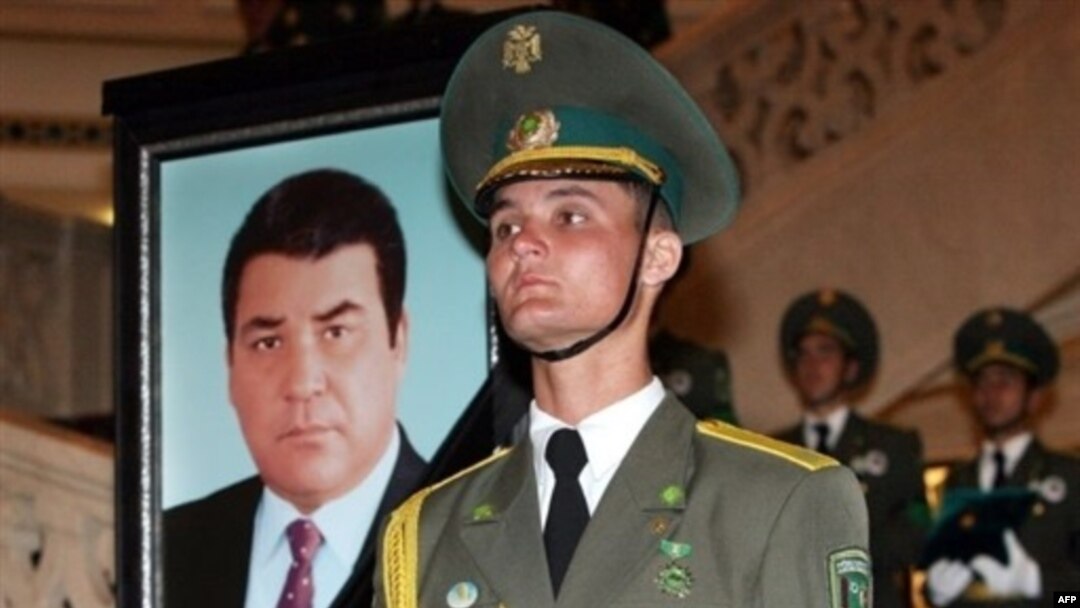In Central Asia, presidential portraits are often seen on the facades of government and public buildings. Portraits of leaders also hang on the office walls of virtually every government official. There even seems to be a telling rule of thumb: the more authoritarian a leader, the more his portraits will adorn the buildings and streets of cities around the country.
But the portrait and statue extravaganza during Niyazov’s 21-year rule was virtually unmatched anywhere -- as was the level of authoritarian rule. Dozens of busts and statues of Niyazov and his family were erected during Turkmenbashi's lifetime.
Ashgabat became well known for Niyazov's gold-plated statue atop the capital's highest building, the Neutrality Arch. The statue, which rotates so that it always faces the sun, became a key manifestation of Niyazov’s personality cult. His image also adorned every banknote of the country's currency. Even the national vodka and other food products bore his portrait and were called "Serdar," or "Great Leader."
Not For Me, But For The People
Niyazov often said he did not want to have his pictures and statues in the streets but it was "what the people wanted." He added: "If I were a worker and my president gave me all the things they have here [for free] in Turkmenistan, I would not only paint his picture, I would have his picture on my shoulder or on my clothing."
But it seems that many of the Niyazov portraits have now been removed, as Berdymukhammedov slowly moves to deconstruct Niyazov's cult of personality.
"I don't see Niyazov's portraits anymore," Rahim Esenov, a prominent writer in Ashgabat, told RFE/RL’s Turkmen Service. "In a clinic where I usually go, his pictures used to cover all the walls completely. Now, they are gone. However, you can still see his busts and statues on the streets."
A source close to the Turkmen government told RFE/RL on condition of anonymity that all government and public institutions have been instructed to remove Niyazov's portraits as well as boards containing excerpts from Niyazov's speeches and his book "Rukhnama," which had become a force-fed "spiritual guide to the Turkmen nation."
According to the instruction -- which is said to have come directly from Berdymukhammedov -- no portraits should be hung on buildings. Portraits of Berdymukhammedov could replace those of Niyazov but only inside government offices, a source told RFE/RL.
Still, Berdymukhammedov's dismantling of the Niyazov personality cult has a long way to go.
Many statues of Niyazov and his mother, Gurbansoltan Eje, can still be seen in Ashgabat and in the country's provinces.
Niyazov's portrait is still on the country's currency, although a decision was made recently to have them replaced with new banknotes without Niyazov's face. The process will take a couple of years.
Meanwhile, observers have voiced concern over a possible cult of personality being established by Berdymukhammedov himself.
A New Cult?
In recent months, numerous reports from Turkmenistan have said that portraits of Berdymukhammedov are replacing those of Niyazov in many places around the capital and elsewhere.
A correspondent for RFE/RL's Turkmen Service in Lebap Province also reported on such a case. "One school director told me that at the beginning of this school year, he was told to take down a portrait of Niyazov and put a huge picture of Berdymukhammedov in its place," the correspondent says. "[He said] the order came from the Education Ministry's district department."
Western media have speculated that Berdymukhammedov has appeared to take steps toward opening up the country. Yet state television reporters now refer to Berdymukhammedov as the "great leader" and newspaper articles extol his virtues.
Bairam Shikhmuradov, an exiled opposition activist, says Berdymukhammedov should stop developing his personality cult, which he says could damage Turkmenistan's international reputation.
"They have started to praise and flatter Berdymukhammedov as much as they did with Turkmenbashi. It looks ugly," Shikhmuradov says. "I hope the president will stop that and not let the situation go as far as it did under Niyazov. Taking into account the prospects of Turkmenistan's relations with the United States, China, and Russia, this nonsense with flattery, portraits, and open letters [of praise] to the president, will become an obstacle for him and his work."
RFE/RL Central Asia Report
SUBSCRIBE For regular news and analysis on all five Central Asian countries by e-mail, subscribe to "RFE/RL Central Asia Report."


